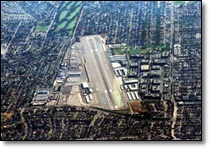 Jet-Ban Ordinance Dead; Future of Jets at SMO Up in Air
Jet-Ban Ordinance Dead; Future of Jets at SMO Up in Air
An ordinance banning jets at Santa Monica Airport has no hope of being revived, now that the City has decided not to bring an appeal before the United States Supreme Court to overturn a lower court’s ruling in favor of the Federal Aviation Administration (FAA).
City Manager Rod Gould let members of Friends of Sunset Park (FOSP) know of the City’s decision at the group’s annual meeting in May. Gould told the group that the city had spent $1.4 million with nothing to show for it and an appeal to the highest court in the land would be expensive and probably fruitless.
The City enacted a 2008 ordinance banning Class C and D jets at SMO in response to fears of airport neighbors that a jet crash was an accident waiting to happen.
The FAA lost no time securing an injunction to stop the ordinance from taking effect until its fight with the City had made its way through the courts, and in January the U. S. Court of Appeals upheld the FAA’s position that the city was bound by an 1984 contract with the agency to allow the jets to use SMO, an outcome that didn’t surprise FAA officials.
“We were always confident of our legal position on the jet ban issue,” FAA spokesman Ian Gregor told The Lookout Thursday.
Now, the City is hoping to work out a new deal with the FAA when the 1984 contract expires in 2014.
“When it expires, we believe that we will have the option as a city to change things up at the airport,” Mayor Richard Bloom took the Lookout Thursday. The possibilities include maintaining the status quo, making changes or closing the airport altogether, Bloom said.
“From my point of view, the status quo is not going to be an acceptable option,” he said. And although “one councilmember from a neighboring city” wants to close the airport, Bloom said “I’m very interested in hearing the full range of options that are out there.”
Residents have long feared that one of the larger jets using SMO might overrun the runway and crash into surrounding neighborhood.
“From the air, SMO looks like an aircraft carrier closely surrounded by a sea of homes,” FOSP President Zina Josephs told the Lookout Thursday. FOSP is one of the organizations that has been most active in voicing residents’ concerns about airport safety to city officials.
“The FAA won’t allow the city to ban the faster, larger Category C and D jets, for which the airport was not designed,” said Josephs. “The FAA won’t allow the city to install standard Runway Safety Areas (RSA’s) at both ends of the runway to protect residents from overruns.
“Without the C and D ban, and without the RSA’s, sooner or later a large, fast jet is probably going to either overrun the runway and barrel into nearby homes, or crash into a residential neighborhood on approach or after takeoff,” she said.
But Gregor said there is something that can be done to make the airport safer, and the FAA is willing to help pay for the solution.
“We have made repeated offers to help the city pay for installing an Engineered Material Arresting System (EMAS) at one or both runway ends,” Gregor said.
“EMAS are beds of crushable concrete blocks that collapse under an aircraft’s weight, slowing the aircraft and helping prevent them from running off runway ends,” and the beds would prevent “runway excursions,” he said.
“Unfortunately, the city has rejected all of our offers to address its stated safety concerns by helping pay to install EMAS,” said Gregor. “Nevertheless, we remain ready, willing and able to help pay for installing EMAS at SMO.”
Residents and city officials have said that EMAS at SMO would be inadequate to prevent at Class C or D jet overruns, although the FAA website indicates seven incidents in which EMAS has safely stopped overrunning aircraft.
But that’s not the only reason why the city is balking at the deal. FAA money comes with strings attached, Bloom said.
“Letting the FAA pay puts us into a relationship that extends the FAA’s jurisdiction,” said Bloom. “The city has been conscientious about paying with our own money” he said. Taking the FAA’s money “would foreclose [the City’s] options.”
And options are what the airport’s future is all about, Bloom said. The city has hired consultants, including Santa Monica-based RAND Corporation, to look into all the possibilities for SMO and draw up lists of options to present to the public in “visioning” workshops this fall.
Then the City Council will take a look at what the consultants and residents have come up with, probably in February 2012, Bloom said. He wasn’t willing to be specific about what choices he anticipates the City will face then.
“I don’t want to preordain what the outcome of the consultants’ review and the public process will be,” said Bloom.
Calpilots Editor’s Note: In any action such as this one where public land is sold to developers, the rule is always follow the money. The question of what is in it for the public figures in Santa Monica must be asked – is some sort of personal gain in it for them? Type in Santa Monica Airport and hit return in the search function upper right, read all the stories abouit how the city has worked to insure the airport fails, and decide for yourself.
